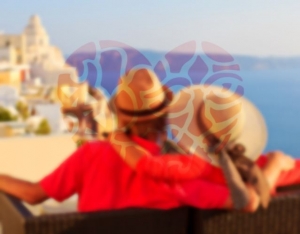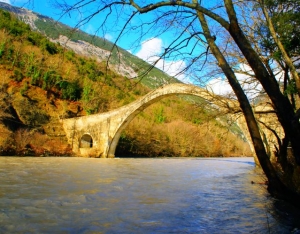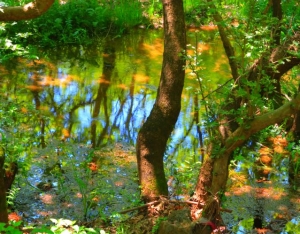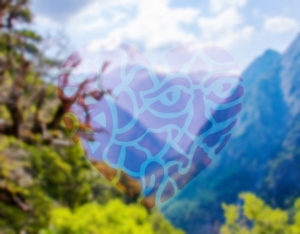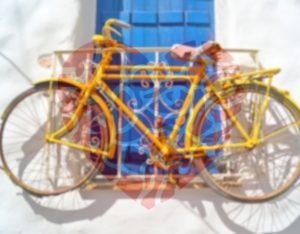Thodoris Bgenopoulos
In Arta you can also find the Castle of Arta.
The Castle of Arta was built in the 13th century AD from the Komneni family that was at the time ruling the Despotate of Epirus. In the ancient times the acropolis of ancient Amvrakia stood where the byzantine castle is currently located.
The Castle of Arta is a characteristic example of byzantine fortress with a wall rising to 10 meters height, lengthwise battlements and towers per 25 meters. On the southwestern edge of the castle, there is a wall that used to be the last bastion of defenders, the so called "Kastraki" or as it was called by the Turks "Iç Kale", meaning acropolis.
During the Ottoman occupation, the castle was used as a prison in which many Greek fighters were detained, including General Makrygiannis.
Today the Castle of Arta is one of the best preserved castles in Greece and is definitely worth a visit. From its walls you will enjoy a breathtaking view of Arta and the surrounding area, while during the summer months many cultural events are organized in the castle.
Once in the city of Arta, head to Arachthos river to find the renown Bridge of Arta.
The Bridge of Arta is the most famous stone bridge in Greece. It is estimated that since ancient times there was a bridge in its current position, while it acquired its present construction in the early 17th century.
The Bridge of Arta has a length of 145 meters and consists of 4 stone arches, which have completely no symmetry between them. It is considered to be the pride and joy of Arta, being also a favorite photo-spot for tourists, locals and photographers as well as the best inspiration for painters.
Beside its beauty and impressive architecture, the Bridge of Arta is famous for the legend that surrounds its building. According to it, the construction of the bridge took several years to be completed. The legend has it that the workers kept finding out every morning that whatever they had built was overnight demolished. And it is said that a bird with human voice gave a prophecy; the bridge will only stand tall if a person is embedded in its foundations, this person has to be the master builder's wife. So this was done and thence forward the bridge stands in its current position. This legend was passed down to us today by a well-known folk song "The Bridge of Arta ".
History researchers are trying to connect the legend with the historical reality, giving their own explanation. According to it, the Turks during the Ottoman occupation had ordered the construction of the bridge so as to make it easier for the army to pass. The Greek residents, not being able to question their orders, did built the bridge in the morning but destroyed the foundation during the night. The Turks in turn, decided to terrify them by killing the master builder (and maybe his wife too), leaving the rest with no other choice than to complete the construction of the bridge, fearing for their own lives.
Whatever the truth, the Bridge of Arta stands now tall and beautiful, magnificent and legendary, awaiting for your visit.
River Arachthos passes through Arta and a part of Ioannina.
Arachthos is the 8th river in length in Greece and the biggest in Epirus, with 110klm length. Its characteristic is the arched bridges that connect its banks, like the renown Bridge of Arta and the beautiful Bridge of Plaka. In Arachthos and especially in the location of Pournari a dam has been constructed (being the second biggest in Greece). This lead to the creation of the artificial lake of Pournari which is now an important wetland. The river opens into the gulf of Amvrakikos, thus creating a delta which is considered to be one of the best retained ecosystems in Greece, as it is either the home or the layover for many different species of birds.
Arachthos is also a favorite spot for rafting, with routes suitable for experts and amateurs.
In the region of Arta, Ioannina and Trikala the mountain of Tzoumerka-Athamanika Ori, rise tall.
Tzoumerka in Arta have as highest peak the Katafidi, with height up to 2393 meters. Other peaks are Agathi, which is the greek word for "thorn", (2392 meters), Gerakovouni, which means the mountain of falcons (2211 meters), Strogoula (2107 meters ) and Sklava, the greek word for "slave" ( 2067 meters).
Tzoumerka-Athamanika Ori, famous for their natural beauty, have been declared as National Park and are a favorite destination for mountain climbing and hiking. Here also you can find numerous villages, called Tzoumerkoxoria, that retain their authenticity and are worth a visit if you want to experience something different than the typical touristy destinations.
Arta is a top choice for those seeking to get in touch with their inner self through nature. Majestic mountains await for you to climb or hike them. Discover the villages of the Tzoumerka mountains ("Tzoumerkoxoria" ) and the unique beauty of hidden landscapes.
The lovers of rafting will find their heaven in the rivers of Arachthos and Acheloos. In an environment of rare natural beauty, you can find extraordinary routes for experienced or amateur sport enthusiasts. In the same rivers you can also canoe-kayak.
Yet, if you are even more extreme you will have the opportunity to go paragliding in Gribovo and find other air sports through the Artas Aeroclub. (www.artafly.gr ).
If you are into horse ridding, you are in the right place. In Arta you will find horses and specialized trainers in case you want to enjoy a lovely nature walk.
However, if you are a different kind of rider, you will find your own little paradise in Artas Pachikalamo area, where there is a high quality motocross track to "ride hard".
On the seashore of the Amvrakikos gulf, you will find the beach of Koronisia.
The truth is that Koronisia beach, which is in front of the homonym village, cannot really compare to the aegean beaches. The waters are shallow and warm and you can easily go swimming if you choose, but in no case is it a top choice. An alternative would be to enjoy the landscape while having a great meal at the small taverns of the area.
Inside the region you can either use your private vehicle or the bus line -KTEL- (www.ktelartas.gr, telephone: 26810 27348). Especially for the city of Arta there is a downtown KTEL available (telephone: 26810 28314). Other options are the taxi (www.taxiartas.gr,telephone: 26810 78332) or the car rentals.
In the southern part of the Arta region lies its capital, Arta.
Its is true that Arta is well-known for its famous bridge of Arta, but it also has rich history and sights. Having a population of around 22 thousand residents, Arta is the second in size city in Epirus, after Ioannina.
Arta's town is built where the ancient Amvrakia stood years ago. This was the city that King Pyrrus named capital of the Kingdom of Epirus in 295 BC. Only few buildings have survived from the ancient city, among which stand out. the small Theater of Amvrakia and the remains of the Temple of Apollo. The roman invasion of 168 BC rips not only the city off from its treasures, but also its residents who are forced to move to ancient Nikopolis. Almost for a millennium the region lives in oblivion, when in the 13th century the Despotate of Epirus is founded, having Arta as the capital; now second prime was ahead of Arta.
After strolling the streets of Arta, its a must to visit the renown Bridge of Arta and feel bits of the legend that surrounds its construction. Following on, you should see the Sacred Temple of Panagia Parigoritisa (Our Lady of Consolation), the Castle of Arta and some of the notable museums of the city like the Archaeological Museum of Arta, the Folklore Museum "Skoufa" and the "Skoufa" Museum of History.
Luckily, after a full day there are many choices for dinner. Taverns, mezedopoleia (traditional greek places where small food plates are served with ouzo or tsipouro) and restaurants have to offer a variety of delightful tastes, together with cafes and bars for a cup of coffee and drinks. As the night falls, do not miss out the vibrant nightlife of Arta and make sure to choose one of its exceptional hotels or guest houses for a good night's sleep.
The first time the region was inhabited, is hinted by the few findings from the neolithic times. In essence, Arta enters the historic map around 625 BC when Corinthian colonists founded the ancient Amvrakia, at the point where the city of Arta stands today.
On 295 BC Pyrrhus, the king of Epirus, transfered the kingdom's capital to Amvrakia, which gradually gained great prestige and power. Pyrrhus went down in history for the battles he gave, and even today there is the famous expression "Pyrrhic victory" (Pirios Niki) which means victory that ends up looking like defeat due to large loss in the army. During his reign, the town grew prosperous and significant projects were made, such as the original bridge at the site where today lies the Bridge of Arta, the small and large theater and the Prytaneion. The town's prosperity goes on until 167 BC, when it is occupied by the Romans and following the founding of Nikopolis finally falls into total decline.
Ancient Amvrakia reappears approximately 1000 years later as Arta. At the dawn of the 13th century Arta becomes the capital of the Despotate of Epirus and lives the second heyday of its history under the governance of the Komneni byzantine family. It is then that the Sacred Temple of Panagia Parigoritisa (Our Lady of Consolation) and the Castle of Arta are constructed.
As the years go by, the region passes through italian and serbian hands, until it falls in 1449 under the ottoman occupation. In 1881, the biggest part of the area is at last connected to Greece according to the Treaty of Berlin, while the flatland of Arta together with the rest of Epirus are set free during the Balkan Wars of 1912-1913.
It is worth noting that in the course of the Second Word War in Greece, one of the biggest massacres of non-combatants took place in the village Kommeno. This is still known today as the "Slaughter of the Village Kommeno".
Arta is a region of Epirus that spreads to 1662 square kilometers and has around to 70 thousand permanent residents. On the northern side it borders with the region of Ioannina, on the east with Trikala and Karditsa, on the west with Preveza and in the south is the region of Etoloakarnania and the Amvrakikos Gulf. Arta is also the capital and biggest city of Epirus.
Most of the area is mountainous (about 70%), with imposing mountains that stand out, such as the Tzoumerka or Athamanika Ori, the Xerovouni and the Ori Valtou.
Arta is surrounded by sea in the southern part of the Gulf of Amvrakikos, thus offering a variety of beautiful beaches. Several rivers cross from its territory. Arachthos, Louros and Acheloos, are some of them. It also has two artificial lakes (that of Arta and Pournari)and several lagoons.
The climate in the mountainous part of the region is continental, with cold winters and relatively cool summers, while in the coast the winter is more mild and the summer hotter. The residents are mainly engaged in agriculture, farming and fishery. At the same time, tourism is gradually growing.

